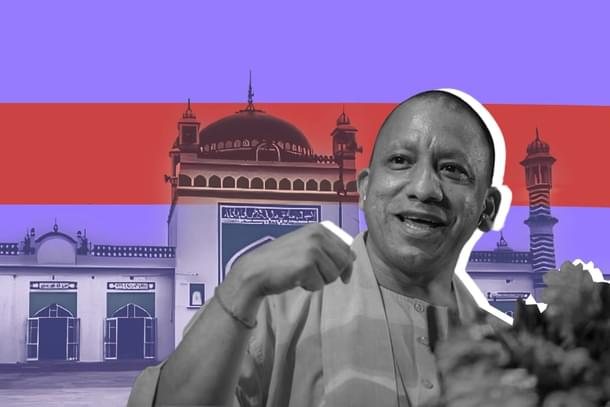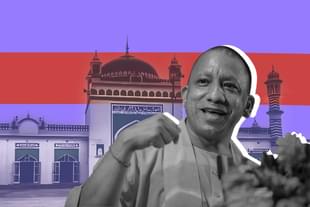Uttar Pradesh
Court Orders Cannot Restrain Yogi Adityanath From Bringing Sambhal Violence Accused To Justice
Nishtha Anushree
Dec 19, 2024, 05:37 PM | Updated 05:37 PM IST
Save & read from anywhere!
Bookmark stories for easy access on any device or the Swarajya app.


The actions of the Yogi Adityanath administration in the aftermath of the Sambhal violence appear to be slightly different from his earlier actions, such as after the anti-Citizenship (Amendment) Act (CAA) riots.
Neither the illegal houses of the accused have been demolished, nor have posters bearing the accused's photos been displayed in public places.
This change is because of certain restraining court orders.
That is not to say, however, that Yogi has gone soft on the perpetrators and is relying solely on the judicial process to bring the 24 November Jama Masjid violence accused to justice.
The Chief Minister (CM) of Uttar Pradesh (UP) has found new lawful ways to deal with the accused. Anti-encroachment drives and keeping a rein on electricity theft are the new methods in Yogi's handbook.
Violence erupted when a court-ordered team went to survey the Jama Masjid temple in Sambhal's Kot West area over claims of the existence of a Hindu temple, named Harihar Temple, at the mosque site.
Several people were injured in the stone-pelting and ensuing violence, including dozens of police personnel, and four civilians were killed in firings, which, the police claim, was not done by the force.
Thereafter, UP Police identified 400 accused persons through CCTV footage, photos, and videos, and decided to display their pictures publicly on posters. However, the move was deferred.
This might be because in 2020, when UP Police did a similar thing after the anti-CAA riots, the Allahabad High Court ordered the removal of the posters, and even the Supreme Court did not back the UP government then.
Similarly, the Yogi administration did not proceed with the demolishing of illegal houses of accused persons due to the Supreme Court's 13 November directive, which introduced stricter criteria for demolition.
The criteria include a notice period of a minimum of 15 days, a guaranteed right to challenge the notice, and the burden of proof on the authorities to prove that demolition is necessary.
However, the Supreme Court exempted public spaces from its directive. And as Swarajya had presumed earlier, Yogi is using this exemption to continue his 'bulldozer justice'.
An anti-encroachment drive was launched on 11 December near the Jama Masjid area in Sambhal, and bulldozers were back in action on the streets despite the Supreme Court directive.
In this drive, the portions of houses extending onto public spaces, like roads and drains, were demolished. Moreover, an electricity pole and a mechanical metre were interestingly found inside a few houses.
These findings in the Deepa Sarai area, within 2 kilometres (km) of the disputed Jama Masjid, gave a new dimension of electricity theft findings to the Yogi administration.
Since then, the electricity department has launched similar drives in the nearby areas of Deepa Sarai, Miya Sarai, Rai Satti, and Hindu Khera in Sambhal and found 176 people accused of electricity theft. A fine of Rs 3.45 crore in total has been imposed on them.
Notably, the electricity department has known about electricity theft in the area for a long time, but they faced resistance, and officials were even beaten up when they tried to take action. However, with the administration's support this time, they are able to proceed with the appropriate measures.
"We have caught power theft in approximately 200-250 houses. We have also caught power theft from above the mosque here. We are also demolishing encroachments. People were warned and notified about this," District Magistrate Rajender Pensiya said.
Notably, Samajwadi Party (SP) Member of Parliament (MP) Zia ur Rehman Barq, who is accused of making a provocative speech on 'Masjid ki hifazat' (the safeguarding of the mosque) during the Friday namaz, is also facing action.
On 5 December, the sub-divisional magistrate (SDM) of Sambhal issued a notice to Barq for not having an approved map of his house under the Uttar Pradesh (Regulation of Building Operations) Act, 1958.
A first information report (FIR) was filed against Barq on 26 November for his provocative speech, but his name also came up in an older hit-and-run case after this FIR.
Earlier today (19 December), a team from the electricity department, along with many security personnel, arrived at the residence of the SP MP over irregularities in electricity use at his premises.
The team read the electricity metre and checked the load of air conditioners (AC), fans, and other electricity equipment, and registered an electricity theft FIR against the MP.
"FIR has been lodged on the basis of Metre Reading Instrument report. We have also made a complaint about the threat given to the team (by the father of Zia ur Rehman Barq)," an official said.
This means that apart from the regular cases of violence, other instances of electricity theft and encroachment will also continue against the accused to ensure comprehensive justice while remaining within the boundaries of the law.
Meanwhile, a domino effect appears to have kicked off in Sambhal. The anti-encroachment drive led to electricity theft findings, and the campaign against electricity theft led to the discovery of a temple that has been reportedly closed since 1978.
The discovery comes at a time when the Supreme Court has put a stay on any trial proceedings or surveys until the validity of the Places of Worship Act, 1991, is determined.
While this order has put a hold on pleas for the Gyanvapi Wazookhana and Ajmer Dargah surveys and the presentation of the Sambhal Jama Masjid survey report, the re-emergence of the forgotten Hindu temple cannot be prevented.
The newly discovered Sambhal temple is located in the Muslim-majority Khaggusarai area, at a distance of 2 km from the disputed Jama Masjid, and is believed to be closed after Hindu families migrated out of the area after the 1978 riots.
This temple is believed to be an ancient Shiv-Hanuman temple, and regular prayers at the temple have restarted. The walls surrounding the temple, which had covered the temple for so long, have been demolished.
After this temple find, broken idols of the Hindu deities, Lord Ganesh, Goddess Lakshmi, and Goddess Parvati, were found in a well, filled with debris and soil, near the temple, believed to be a temple well.
After the discovery of this temple on 14 December, another temple was unlocked by the authorities on 17 December. The second temple is also in a Muslim-majority area, Hayat Nagar, and was reportedly locked for decades.
Nishtha Anushree is Senior Sub-editor at Swarajya. She tweets at @nishthaanushree.





